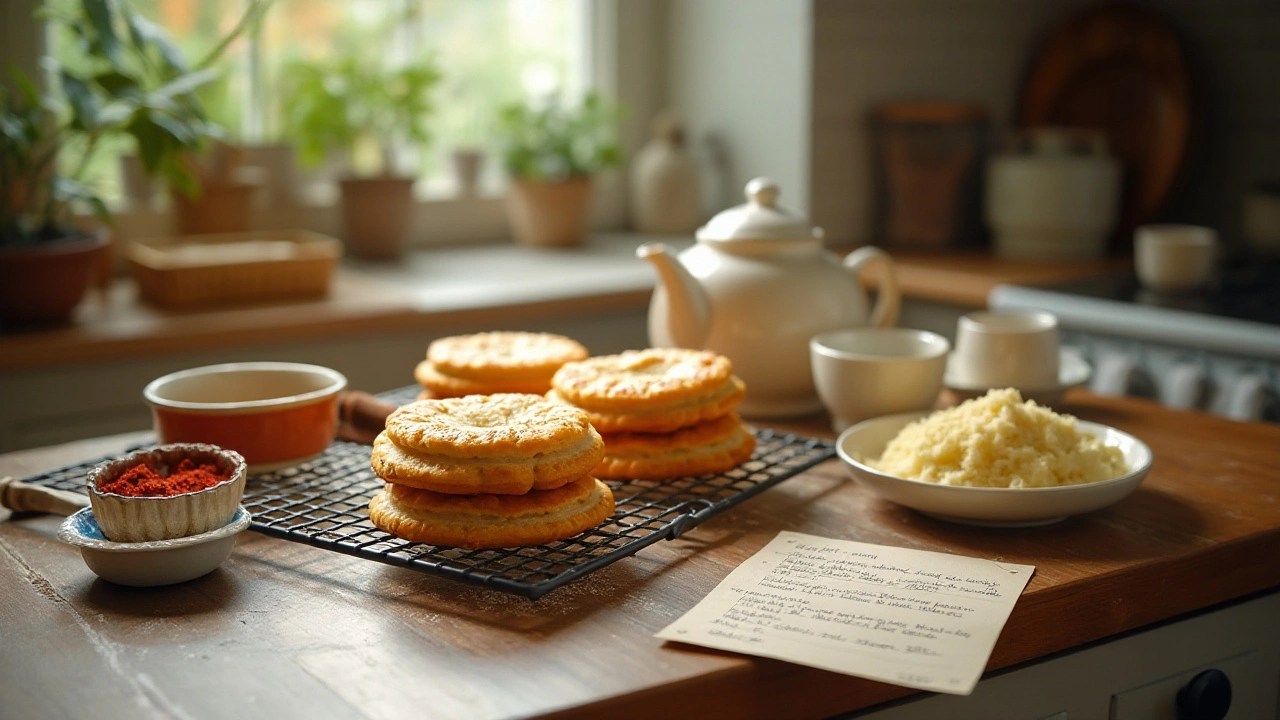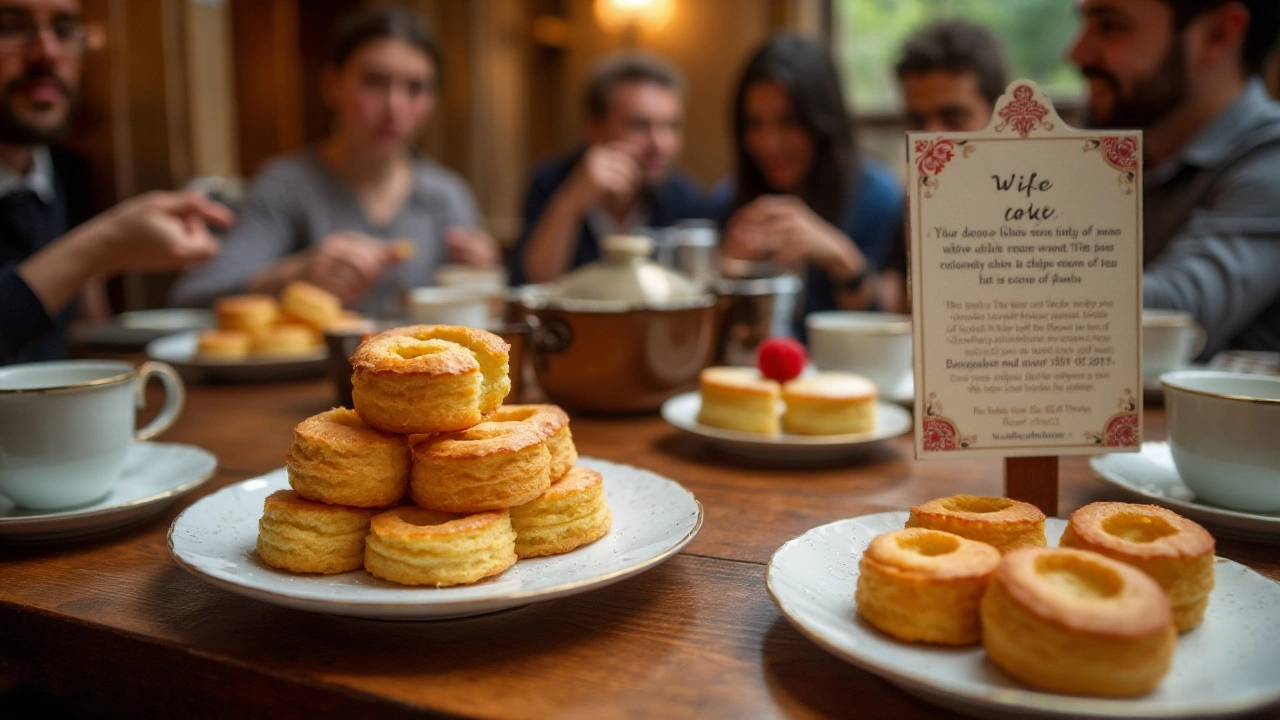
The delightful and enigmatically named 'Wife Cake' is a Chinese pastry that carries a storied past. With its golden, flaky crust and sweet, chewy filling, this dessert is more than just a treat—it's a piece of history served on a plate. But why is it called 'Wife Cake'?
The tale traces back to ancient times, steeped in romance and devotion, captivating those who savor it with every bite. Uncover the legend, learn the secrets of its ingredients, and explore the tradition this cake embodies. Whether you're a seasoned baker or a curious taster, there's a slice of knowledge waiting for you in this sugary journey.
- The Legend Behind the Name
- Cultural Significance and Traditions
- Core Ingredients of Wife Cake
- Step-by-step Baking Guide
- Tips for Perfecting the Cake
- Interesting Facts and Variations
The Legend Behind the Name
The tale of the Wife Cake, also known as 'Lo Poh Beng', is a heartwarming fusion of love and creativity. As legend has it, the origins of this delightful pastry date back to the Imperial China period, specifically during the Qing Dynasty. In a humble village, there was a young couple known for their deep love and unwavering bond. However, like many romantic tales, their happiness was overshadowed by hardships. The husband fell into severe debt, threatening their family's stability. Determined to support him, the wife decided to take matters into her own hands.
Overcoming social norms that often restrained women, she concocted a recipe using simple ingredients they had. This innovative creation resulted in a pastry that surprised the village with its deliciousness and simplicity. The sweet filling, mainly comprising of winter melon, subtly combined with a flaky crust, quickly gained popularity. The wife sold these cakes, saving her family from the brink of poverty. The villagers fondly named the pastry after her as a tribute to her love and sacrifice. Interestingly, the legendary origins embody the values of perseverance and ingenuity often cherished in Chinese culture.
Famed cultural historian Li Mao adds, 'The Wife Cake is not simply a pastry; it's a testament to the resilience and resourcefulness of women throughout history.'
This story of devotion transcended generations, making the Wife Cake a historical emblem of love. Each bite of this pastry carries with it the essence of an era where culinary skill was a matter of survival and creativity. While the original recipe has variations depending on the region, the primary ingredients have remained largely unchanged. The soft yet sweet winter melon paired with roasted sesame and a sprinkle of sugar creates a harmonious balance that resonates with the underlying tale of harmony and sacrifice.
Legend has it that the wife’s act of love and bravery became a revered narrative across China, highlighting the crucial role of women in both familial and economic resilience. Today, enjoying this cake during festivals is a tribute to personal sacrifice and mutual support in relationships. The sweet combination of legend and taste has traveled far beyond its geographical and historic origins, weaving its way into the hearts of people worldwide, who appreciate not just its taste but the poignant story it tells.
Cultural Significance and Traditions
The Wife Cake, known for its appealing sweetness and flaky texture, is not merely a dessert; it is an embodiment of love, tradition, and cultural heritage. This pastry has its roots in southern China, specifically the Guangdong region, where it is a frequent feature in both celebratory banquets and simple family gatherings. The beloved dessert is often associated with filial piety and marital harmony, traits highly valued in traditional Chinese society.
One of the charming stories behind the Wife Cake speaks of a devoted wife who created the cake to sell and save her family from poverty, showcasing the themes of sacrifice and ingenuity. These qualities are cherished in Chinese culture and are often passed down from generation to generation. Such tales are more than just stories; they serve as a cultural compass, reminding the younger generations of the values and morals that have been cherished by their ancestors. Some families even have their own renditions of the story, tweaking details to resonate more personally with their heritage.
In terms of tradition, Wife Cakes are popular around the time of Mid-Autumn Festival, a celebration centered on family reunions and thanksgiving. They are traditionally shared among family members, strengthening bonds and symbolizing unity. Sharing a cake is no small gesture; it is a reflection of generosity and family ties, which are central tenets of Chinese societal and familial structures. In some regions, offering a Wife Cake is akin to offering a token of peace or friendship, thereby enriching its role in social dynamics.
A particular aspect of their cultural portrayal is their inclusion in tea ceremonies, which are influential in Chinese culture. A quote from Lin Yutang, a renowned cultural writer:
"There is something in the nature of tea that leads us into a world of quiet contemplation of life."This applies to Wife Cakes just as well, as they are often savored with tea, complementing the quiet gratitude and reflection that the ritual inspires.
These pastries are not only tied to celebratory events but also play a role in everyday life. In Hong Kong, for instance, where they are sometimes referred to as 'lou po beng,' they have become a staple pastry found in bakeries and enjoyed as a daily treat or breakfast item. A diverse palate of fillings and textures have evolved from the original recipes, including variations that contain winter melon, which is reputed to have cooling properties according to traditional Chinese medicine. Such diversity in recipes speaks to the regional adaptations and creative expressions found throughout Chinese cuisine.
The cultural significance of Wife Cakes extends beyond borders, reaching diasporas across the world. In places like Chinatowns in various countries, these cakes serve as a nostalgic reminder of home, helping to preserve cultural identity and bring communities together. The cakes adapt to the flavors and ingredients available internationally while keeping the heart of the recipe intact, allowing for both preservation and innovation within culinary traditions.

Core Ingredients of Wife Cake
Creating a delicious wife cake requires a harmonious blend of traditional ingredients that come together in perfect symphony. The main component, the crust, is celebrated for its lightness and flaky texture, achieved by using a mixture of both lard and flour. This combination is essential for getting the right consistency and gives the pastry its characteristic layers. Often, bakers use two types of dough, known as oil dough and water dough, which are rolled and folded together to achieve the delicate, flaky texture that defines the pastry. Substituting the lard with butter is an option for those who seek a different aroma, but traditionalists insist that the authentic flavor comes from keeping with the original ingredients.
At its core, the filling is what gives the wife cake its sweetness and charm. It's primarily made from a combination of candied winter melon, white sesame seeds, glutinous rice flour, and sugar. This sweet concoction not only provides a chewy texture but also balances the crust's richness with its mild sweetness. Winter melon might seem an unusual choice for many, but its subtle flavor captures the essence of tradition in each bite. To enhance the sweetness, some bakers include dried coconut or almond paste, adding layers of flavor to the filling while still respecting the traditional roots. As a finishing touch, a glossy sugar syrup is brushed over the entire cake before baking, creating a glistening exterior that captivates both the eyes and the taste buds.
Understanding the role of each ingredient is vital. An old Chinese saying goes, "A pastry speaks of its maker," which reflects the care and precision needed in its crafting.
As acclaimed food historian Linda Civitello says, "Food is one of the most powerful expressions of identity."The choice of ingredients, therefore, isn't just about taste—it's about preserving a cultural identity that has spanned generations. These ingredients tell a story, one that echoes the devotion embedded in the narrative behind this delightful pastry. Through their meticulous preparation, the love and care put into each wife cake become evident, making every bite a tapestry of heritage, skill, and sentiment.
Step-by-step Baking Guide
Baking Wife Cake, or 'Lo Poh Beng', at home is a delightful and rewarding culinary project. By combining the right ingredients with a touch of patience, you can achieve the classic flaky crust and luscious filling that makes this traditional pastry so beloved. Let’s embark on this baking journey, where history and culinary art come together seamlessly.
To start off, gather your ingredients. You will need flour, sugar, water, lard, and sweet winter melon for the filling. These humble components work together to create a harmony of textures and flavors that dance on the taste buds. If you'd like to experiment, consider the texture: the delicate balance between the thin, crisp pastry and the moist, sweet-sticky filling is what makes it truly special. Set aside enough time for preparation, as the key to good baking is often found in unhurried attention to detail.
Ingredients Preparation
Begin with the dough, which is the soul of Wife Cake. You'll need to make two types—oil dough and water dough. For the oil dough, mix flour with lard until it reaches a crumbly consistency. Meanwhile, the water dough is prepared by mixing flour with water and sugar until it forms a smooth, elastic dough. The interplay of these two creates that signature flaky crust. Once ready, let them rest. Resting allows the ingredients to mingle and the gluten to relax, facilitating easier shaping later on.
Filling Making Process
The sweet filling is made of mashed winter melon combined with sugar and lard until it becomes a thick paste. This filling is not just sweet and comforting; it's packed with tradition. Historical tales mention the use of winter melon for its long-lasting and hydrating properties, something crucial in ancient times when preservation of ingredients was key. It gives the cake its distinct flavor profile that stays true to its roots.
Assembly and Baking
Now, for the assembly: roll the rested doughs into small rounds, and pack the filling snugly inside. The technique here is reminiscent of making little pocket pastries, ensuring the edges are sealed so the delicious filling doesn’t escape during baking. Each assembled pastry should look like a tiny, domed treasure. Preheat your oven to a moderate temperature. Baking at less aggressive heat lets the layers slowly rise and separate into that buttery goodness without burning the outer crust. Place them on a lined baking tray, leaving space between each to allow them to expand gracefully.
"Baking is more than just creating a dessert; it's preserving a story," says renowned chef and pastry historian, Anna Chang. "Through carefully re-creating these age-old recipes, we keep tradition alive and infuse it with our own touch."
The aroma that fills your kitchen during the baking process is warm and inviting, encouraging memories of heritage and making new ones. After allowing the Wife Cake to cool, you'll first notice the crisp, golden exterior giving way to a sweet, moist center. The contrasting textures tell the tale of meticulous layering and the melting of rich flavors. Serve it with a hot cup of oolong tea, and you'll have a beautifully balanced experience that pays homage to its traditional Eastern origins.

Tips for Perfecting the Cake
When it comes to making the perfect wife cake, patience and attention to detail can make all the difference. The journey begins with selecting the right ingredients. It's crucial to use fresh, quality products, as these form the essence of this beloved Chinese dessert. The importance of fresh winter melon cannot be overstated, as it forms the base of the cake's distinctive sweet filling. The consistency of the winter melon paste is something that demands careful attention. It needs to be cooked down to just the right thickness, ensuring it holds together without being too dry or overly sticky. Finding this balance is key to achieving that melt-in-the-mouth texture that is so characteristic of a good wife cake.
The dough for the flaky crust requires its own mastery. One significant aspect is the way the dough is rolled out and folded, similar to the technique used in creating puff pastry. This method creates those coveted thin, crisp layers that encase the sweet filling. An even and consistent thickness across all layers is crucial here. Some bakers employ a double laminating technique, folding and rolling the dough multiple times to further enhance the flakiness. If you find yourself struggling with consistency, don't be shy to practice a few times before the big bake. As the old saying goes, practice makes perfect, and in baking, this couldn't be more true.
Temperature and Timing
The oven setup plays a surprisingly large role in the success of your wife cake. Preheat the oven fully before baking, as this ensures a steady rise and proper flakiness in the pastry. A too-hot oven risks burning the cake’s exterior, while a cooler one won't properly crisp the layers. 180°C is generally considered the sweet spot, but be sure to keep a vigilant eye on that first batch to suit your specific oven’s quirks. Timing is equally essential – overbaking can dry out the tender filling, while underbaking leaves the pastry soggy. A bake time of around 20 to 25 minutes is usually perfect, giving just enough time for the layers to crisp while leaving the filling succulent.If you would like to try a success story, taking note from traditional household recipes can offer useful insights. As the renowned Hong Kong pastry chef, Mei-Chun Lee shares,
"The secret lies in giving time and love: time for the dough to rest, love from each fold. A good wife cake tells its own story with every bite."Mitigating common issues such as cracking or melting fillings involves attention to ambient humidity in your workspace. A slightly less hydrated dough can prevent cracking, and chilling the pastries before baking can help maintain shape. These tips will not only ensure successful results but bring your wife cakes to life with authenticity and charm.
Interesting Facts and Variations
When you delve into the storied history of Wife Cake, you uncover a tapestry of anecdotes and culinary wisdom. The pastry is deeply engrained in Chinese culture, with its roots tracing back to the southern region of Guangdong. The most popular legend speaks of a devoted wife who concocted the cake to sell on the streets as a means to pay for her father-in-law's medicine. Her ingenuity and dedication captured the hearts of many, thus giving the confection its name. This touching origin story not only highlights the cake's humble beginnings but also imbues it with a sense of familial duty and love, making it a cherished symbol across generations.
Traditionally known as 'Lo Poh Beng' in Cantonese, Wife Cake showcases a delicate balance between texture and flavor. The outer shell is crafted from a tender, flaky pastry that gives way to a rich, sweet filling typically made from winter melon, almond paste, and sesame seeds. What makes this pastry truly fascinating is the variety of regional adaptations that exist. In some areas, the filling is tweaked with the addition of essence like vanilla or a touch of coconut, adding a contemporary twist to the classic taste. Enthusiasts of this dessert are often pleasantly surprised by these subtle variations that each offer a unique sense of place.
In recent years, Wife Cake has gained international attention, and creative bakers around the world have taken to incorporating unique ingredients that reflect global palates. Some variations replace the winter melon with sweet potatoes or taro, achieving an equally delightful result, while others play with the addition of nuts like walnuts or pecans for added crunch. This evolution of the cake not only introduces new flavors but also demonstrates the adaptability of traditional recipes that honor their cultural roots while embracing contemporary tastes.
One noteworthy insight into the popularity of Wife Cake is encapsulated in the words of culinary historian Zhang Wei:
"The significance of these pastries transcends their taste; they embody the essence of tradition, telling stories of their origins, and revealing the inventive ways they have been adapted across time."This sentiment mirrors the universality of such traditions and highlights how such desserts can act as cultural bridges. Today, whether enjoyed in its classic form or an inventive variation, Wife Cake remains a pastry that invites curiosity and appreciation from sweet enthusiasts around the globe.
For those looking to explore beyond the traditional, bakeries in urban hubs often feature an array of experimental tweaks. Chocolate-infused pastry layers, mango-flavored fillings, or even matcha-infused crusts offer a taste test like no other. Such innovations not only appeal to modern palates but also ensure that this storied pastry continues to evolve, keeping its charm alive and its flavors captivating. So next time you bite into a Wife Cake, take a moment to savor its richness—savor both its taste and its story.